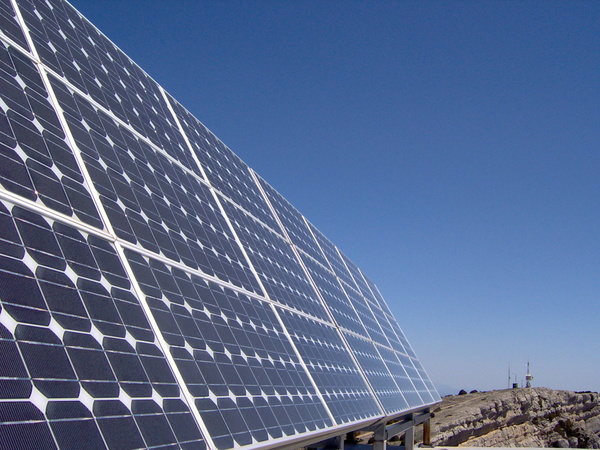|
in a pair of recently published reports, shanchao lin, a professor at florida a&m and florida state universities, has theorized that organometal halide perovskites could provide more flexible mechanical properties than silicon and other inorganic materials and also be more energy efficient as well.

these calaculations could lead to the production of more efficient solar cells. (wikimedia commons)
using mathematical simulations, lin refuted previous beliefs that these organic-inorganic hybrid materials would be easily damaged, according to a report on the florida state website. instead, he predicted that the material would fracture slowly through “crystalline-to-amorphous transition,” which would make them tougher than previously thought.
the article explained, “before mechanical failure, they might absorb twice as much elastic energy from external loading than currently used materials in electronic devices, such as silicon and gallium arsenide.”
in addition, lin predicted that the hybrid materials would have very low thermal conductivity due to their organic component and would be “ideal” for thermoelectric energy conversion.
lin said, “even more exciting, hybrid perovskites-based solar cells are four times as efficient, in terms of quantum yield, than polymer-based ones. they are also as efficient as the current, mainstream silicon-based solar cells but are much more flexible and cheaper to make from a solution phase through a procedure very similar to inkjet printing.”
these new materials could be used in application such as solar cells, thermoelectric devices and led.
the work on the mechanical properties of the hybrid perovskites was published in as nano. the abstract stated:
“we predict the elastic constant matrix and various elastic properties of ch3nh3pbi3 (mapbi3) using atomistic simulations. we find that single-crystalline mapbi3 is much stiffer and exhibits higher ultimate tensile strength than polycrystalline samples, but the latter exhibit unexpected, greatly enhanced nanoductility and fracture toughness, resulting from the extensive amorphization during the yielding process.
“more interestingly, polycrystalline mapbi3 exhibits inverse hall–petch grain-boundary strengthening effect, in which the yield stress is reduced when decreasing the grain size, due to amorphous grain boundaries. by monitoring the centro-symmetry parameter and local stress evolution, we confirm the soft and nanoductile nature of defective mapbi3 with a crack.
“by conducting atomic stress decomposition, we attribute such fracture toughness primarily to the strong electrostatic interactions between the ionic components. the observed limited brittle fracture behavior is attributed to the transformation of partial edge dislocations to disordered atoms (nanovoid formation).
“a significant plastic deformation region is observed when nanovoids enlarge and coalesce with adjacent ones, which ultimately leads to crack propagations via ionic-chain breaking. after comparing with traditional inorganic energy-related materials, we find that hybrid perovskites are more compressible and can absorb more strain energy before fracture, which makes them well suited for wearable functional devices with high mechanical flexibility and robustness.”
the thermal and electrical conductivity of the materials was published in advanced functional materials. the abstract read:
“energy-related functionality and performance of organic–inorganic hybrid perovskites, such as methylammonium lead iodide (mapbi3), highly depend on their thermal transport behavior. using equilibrium molecular dynamics simulations, it is discovered that the thermal conductivities of mapbi3 under different phases (cubic, tetragonal, and orthorhombic) are less than 1 w m−1k−1, and as low as 0.31 w m−1 k−1 at room temperature.
“such ultralow thermal conductivity can be attributed to the small phonon group velocities due to their low elastic stiffness, in addition to their short phonon lifetimes (<100 ps) and mean-free-paths (<10 nm) due to the enhanced phonon–phonon scattering from highly-overlapped phonon branches. the anisotropy in thermal conductivity at lower temperatures is found to associate with preferential orientations of organic ch3nh3+ cations.
“among all atomistic interactions, electrostatic interactions dominate thermal conductivities in ionic mapbi3 crystals. furthermore, thermal conductivities of general hybrid perovskites mabx3 (b = pb, sn; x = i, br) have been qualitatively estimated and found that sn- or br-based perovskites possess higher thermal conductivities than pb- or i-based ones due to their much higher elastic stiffness.
“this study inspires optimal selections and rational designs of ionic components for hybrid perovskites with desired thermal conductivity for thermally-stable photovoltaic or highly-efficient thermoelectric energy harvesting/conversion applications.”
|